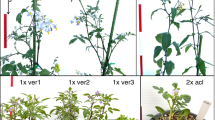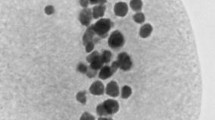Abstract
A program of sexual polyploidization was carried out in alfalfa using plants from wild diploid species that produced male or female unreduced gametes. Sixteen progenies from 2x-4x and 2x-2x crosses were examined with a combination of morphological, cytological and molecular analyses. The chromosome counts revealed diploid, tetraploid and aneuploid plants. Plants with B chromosomes were also detected. The leaf area of the plants was a useful characteristic for distinguishing tetraploid from diploid plants obtained by unilateral or bilateral sexual polyploidization. Leaf shape and leaf margin were not correlated with the ploidy levels. Plants with supernumerary chromosomes displayed obovate or elliptic leaves which differed markedly from the range of forms typical of diploid and tetraploid alfalfa plants. RAPD markers were investigated in all progeny plants to determine maternal and paternal amplification products. Three alfalfa-specific primers proved to be effective in revealing the hybrid origin of the plants. A combination of cytological, morphological and molecular analyses is essential for a detailed genetic characterization of progenies in programs of sexual polyploidization.
Similar content being viewed by others
References
Agarwal K, Gupta PK (1983) Cytological studies in the genus Medicago Linn. Cytologia 48:781–793
Barcaccia G (1994) Development, comparability and potential applications of RAPD markers in the genus Medicago. J Genet Breed 48:161–168
Barcaccia G, Tavoletti S, Pezzotti M, Falcinelli M, Veronesi F (1994) Fingerprinting of alfalfa meiotic mutants using RAPD markers. Euphytica 80:19–25
Barnes DK (1966) Flower color inheritance in diploid and tetraploid alfalfa: a re-evaluation. USDA Tech Bull 1353. US Government Printing Office, Washington, DC
Bingham ET (1980) Maximizing heterozygosity in autotetraploids. In: Lewis WH (ed) Polyploidy: biological relevance. Plenum Press, New York, pp 471–489
Bingham ET (1990) Backcrossing tetraploid into diploid Medicago falcata L. using 2n eggs. Crop Sci 30:1353–1354
Bingham ET, Groose RW, Woodfield DR, Kidwell KK (1994) Complementary gene interactions in alfalfa are greater in autotetraploids than diploids. Crop Sci 34:823–829
Busbice TH, Wilsie CP (1966) Inbreeding depression and heterosis in autotetraploids with application to Medicago sativa. Euphytica 15:52–67
Demarly Y (1963) Génétique des tetraploids et amélioration des plants. Ann Amélior Plant 13:307–400
Demarly Y (1979) The concept of linkat. In: Zeven AC, van Harten AM (eds) Proc Conf Broadening Genetic Base of Crops. Centre for Agricultural Publishing and Documentation, Wageningen, Netherlands. Pudoc, Wageningen, pp 257–265
Dumbier MW, Bingham ET (1975) Maximum heterozygosity in alfalfa: results using haploid-derived autotetraploids. Crop Sci 15:527–531
Edwards K, Jonstone C, Thompson C (1991) A simple and rapid method for the preparation of plant genomic DNA for PCR analysis. Nucleic Acids Res 19:1349
Groose RW, Talbert LE, Kojis WP, Bingham ET (1988) Progressive heterosis in autotetraploid alfalfa: studies using two types of inbreds. Crop Sci 29:1173–1177
Heyn C (1956) Some chromosome counts in the genus Medicago. Caryologia 1:160–165
Heyn C (1963) The annual species of Medicago. Scri Hierosol Publ, Hebrew Univ, Jerusalem 12:1–154
Jones RN, Rees, M (1967) Genotypic control of chromosome behaviour in rye. XI. The influence of B chromosomes on meiosis. Heredity 22:333–347
Johnston SA, denNijs TPM, Peloquin SJ, Hanneman RE (1980) The significance of genetic balance to endosperm development in interspecific crosses. Theor Appl Genet 57:5–9
Mariani A, Tavoletti S, Veronesi F (1993) Abnormal macrosporogenesis in five alfalfa (Medicago sativa) mutants producing 4n pollen. Theor Appl Genet 85:873–871
McCoy TJ, Rowe DE (1986) Single-cross alfalfa (Medicago sativa L.) hybrids produced via 2n gametes and somatic chromosome doubling: experimental and theoretical comparisons. Theor Appl Genet 72:80–83
McCoy TJ, Echt CS (1992) Chromosome manipulations and genetic analysis in Medicago. In: Dudley JW, Hallauer AR, Veilleux RE (eds) Plant breeding reviews, vol X/6, pp 169–197
Motzo R, Calderini O, Veronesi F (1994) Germplasm transfer to cultivated alfalfa mediated by 2n gametes. J Genet Breed 3:277–280
Pfeiffer TW, Bingham ET (1983) Abnormal meiosis in alfalfa, Medicago sativa: cytology of 2n eggs and 4n pollen formation. Can J Genet Cytol 25:107–112
Tavoletti S, Mariani A, Veronesi F (1991a) Cytological analysis of macroand micro-sporogenesis of a diploid alfalfa clone producing male and female 2n gametes. Crop Sci 31:1258–1263
Tavoletti S, Mariani A, Veronesi F (1991b) Phenotypic recurrent selection for 2n-pollen and 2n-egg production in diploid alfalfa. Euphytica 57:97–102
Tavoletti (1994) Cytological mechanisms of 2n-egg formation in a diploid genotype of Medicago sativa subsp. falcato. Euphytica 75:1–8
Veronesi F, Mariani A, Bingham ET (1986) Unreduced gametes in diploid Medicago and their importance in alfalfa breeding. Theor Appl Genet 72:37–41
Veronesi F, Mariani A, Tavoletti S (1988) Screening for 2n-gamete producers in diploid species of the genus Medicago. Genet Agric 42:187–200
Vorsa N, Bingham ET (1979) Cytology of 2n-pollen formation in diploid alfalfa, Medicago sativa. Can J Genet Cytol 21:525–530
Williams JGK, Kubelik AR, Livak KJ, Rafalski JA, Tingey SV (1990) DNA polymorphisms amplified by arbitrary primers are useful as genetic markers. Nucleic Acids Res 22:6531–6535
Author information
Authors and Affiliations
Additional information
Communicated by F. Salamini
Rights and permissions
About this article
Cite this article
Barcaccia, G., Tosti, N., Falistocco, E. et al. Cytological, morphological and molecular analyses of controlled progenies from meiotic mutants of alfalfa producing unreduced gametes. Theoret. Appl. Genetics 91, 1008–1015 (1995). https://doi.org/10.1007/BF00223913
Received:
Accepted:
Issue Date:
DOI: https://doi.org/10.1007/BF00223913




